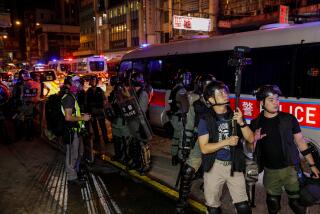Blast from the past
DOES THIS SOUND familiar? Disaffected and reckless young British men with genuine grievances, fueled by religious fanaticism, foolishly imagined that a terrible act would advance their cause. Instead, their conspiracy led to a growing suspicion of their coreligionists increased repression, isolation and confrontation.
That’s a fair description of the British subway bombings on July 7, 2005. But it also describes the Gunpowder Plot, one of the most audacious terrorist schemes in history, which took place in London 401 years ago Sunday.
Despite the differences and the distance, the effect of the 1605 conspiracy and its aftermath can provide us with some insight into our current troubles -- not least, the hope that someday they may come to mean very little in the grand scheme of things.
What happened in 17th century Britain is well known to every English schoolchild. A handful of young Catholic men, frustrated by Britain’s growing oppression of Catholics, decided to blow up the Protestant king, James I, and the whole of Parliament on Nov. 5, 1605.
The plot was uncovered a few hours before Guy Fawkes, one of the 13 plotters, was supposed to ignite 36 barrels of gunpowder under the House of Lords. According to modern calculations, the blast would have destroyed the House of Lords, killing most everyone within a 100-yard radius, including the king, key ministers and members of Parliament. Fawkes, tortured on the rack, named all his co-conspirators, who were either killed during capture or executed.
None of that cured the underlying problem: a country riven by religious difference. England’s Catholic population -- 40,000 out of about 4 million -- was viewed uniformly but unfairly as treacherous in the wake of the plot. Catholics were subjected to increased surveillance, oppression and intimidation. They were obliged to conduct all their religious business -- including weddings and funerals -- in Protestant churches, and they were fined if they did not attend Anglican services. They were prevented from being lawyers or military officers, were banned from universities and forbidden from voting. And, in 1613, Parliament seriously discussed making Catholics wear red hats or striped socks in public so they could be “hooted at.”
Popular distrust of Catholics grew when James’ successor, Charles I, married a French Catholic in 1625 and it became obvious that the court was increasingly influenced by Catholics. Although there were no more terrorist plots after 1605, the years of oppression had an inevitable consequence. Even the Catholic poor, who might have been expected to support the parliamentary forces, sided with the monarchy when civil war split Britain -- king against Parliament -- in the 1640s. Religion and politics intermingled to produce a mixture more explosive than Fawkes’ gunpowder.
It is not hard to see parallels between the events at the beginning of the 17th century and the situation today. Since 9/11, and the bombings of July 2005, British Muslims have been the focus of attention from media, politicians and security services. Police raids on innocent families, government plans to monitor “Asian-looking” university students and widespread hostility to the tiny minority of Muslim women who wear a full veil have contributed to a legitimate feeling of victimization among many British Muslims. Will it also contribute to more violent acts?
In the end, it took centuries of social change to overcome the tensions that made the Gunpowder Plot so crucial to English history. In most parts of Britain, there is now no conflict between Protestants and Catholics, and Fawkes has passed into folklore -- on Nov. 5, millions gather around bonfires to celebrate the foiling of the plot. Children will chant “Remember! Remember! The fifth of November! Gunpowder treason and plot!” -- and everyone will watch a safe, surrogate fireworks explosion.
In some parts of the country, the tradition of burning Fawkes in effigy persists, although today’s “Guys” (the name became slang first for men and then all people) are almost as likely to sport the mask of George W. Bush or Tony Blair as the traditional mustachioed image of Fawkes.
Will the religious and political tensions that afflict the planet eventually fade away, much as the Gunpowder Plot’s motivations have faded? Let’s hope so. And let’s hope that we don’t have to wait four centuries.
More to Read
Sign up for Essential California
The most important California stories and recommendations in your inbox every morning.
You may occasionally receive promotional content from the Los Angeles Times.










